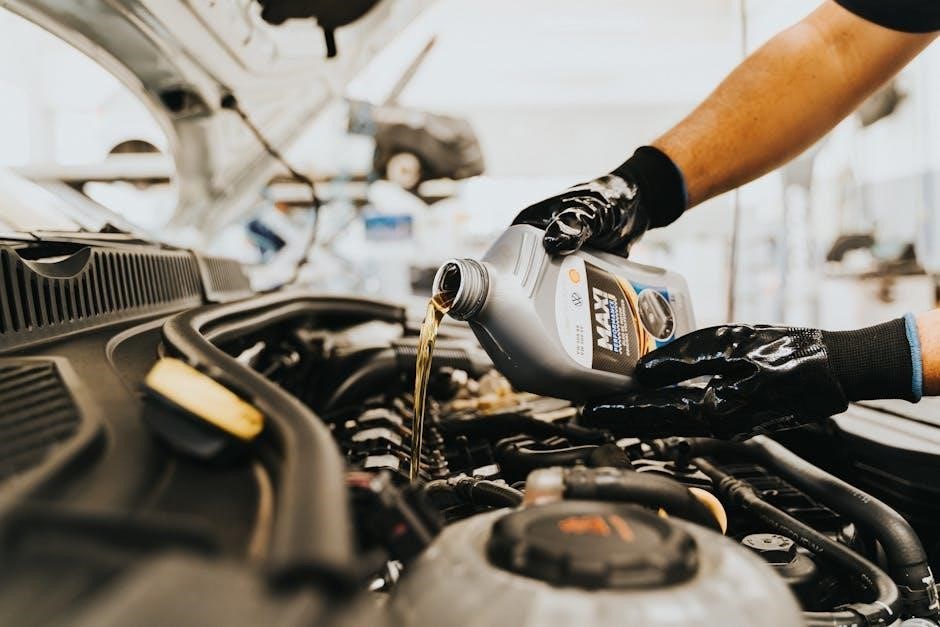Overview of the New Holland Engine Oil Capacity Chart PDF
The New Holland Engine Oil Capacity Chart PDF is a comprehensive guide detailing oil specifications, capacities, and optimal usage for various tractor models. It ensures proper lubrication, prevents overheating, and protects against wear, while maintaining performance and longevity. Using the correct oil volume is crucial for avoiding engine damage and ensuring warranty compliance.
1.1 Purpose and Key Features of the Chart
The New Holland Engine Oil Capacity Chart PDF serves as a detailed guide for tractor maintenance, providing precise oil capacity specifications, viscosity grades, and recommended oil types. Its key features include model-specific data, ensuring accurate lubrication for optimal performance. The chart simplifies maintenance by offering a quick reference, reducing guesswork and potential errors. It also ensures compliance with manufacturer standards, preserving warranty validity. This resource is indispensable for maintaining optimal tractor functionality and extending its operational lifespan.
1.2 Importance of Engine Oil Capacity for Tractor Maintenance
Proper engine oil capacity is vital for maintaining optimal tractor performance and longevity. Incorrect oil levels can lead to engine damage, reduced efficiency, or system failure. Proper lubrication prevents overheating, wear, and tear, while ensuring compliance with manufacturer specifications. It also prevents contamination and corrosion, extending the engine’s lifespan. Regular checks and adherence to recommended capacities are essential for smooth operation and to avoid costly repairs. Accurate oil levels safeguard the tractor’s warranty and ensure reliable functionality.

Understanding Engine Oil Capacity
Engine oil capacity refers to the specific amount of oil an engine requires for optimal performance and lubrication. It varies by model and ensures proper engine operation.
2.1 Why Engine Oil Capacity Matters for Tractor Performance
Engine oil capacity is crucial for tractor performance as it ensures proper lubrication, prevents overheating, and reduces wear. Incorrect levels can damage components, decrease efficiency, or lead to system failure. Proper oil levels maintain the tractor’s warranty and prevent contamination, extending engine lifespan. Regular checks ensure smooth operation and prevent costly repairs, making it vital for owners to follow specified capacities for optimal functionality and longevity.
2.2 Consequences of Incorrect Oil Levels
Incorrect engine oil levels can lead to severe consequences, including engine damage, reduced efficiency, and potential system failure. Overfilling may cause oil leaks or damage to seals and gaskets, while underfilling can result in inadequate lubrication, increased wear, and overheating. Both scenarios can shorten the engine’s lifespan and lead to costly repairs. Proper oil levels are essential to maintain optimal performance, prevent mechanical issues, and ensure the tractor operates efficiently under various conditions. Always adhere to the recommended capacities to avoid these risks.

How to Read the New Holland Engine Oil Capacity Chart
The chart provides a detailed, model-specific guide to determine the correct oil capacity and grade for your tractor. Use it to ensure accurate measurements and avoid errors.
3.1 Navigating the Chart: Oil Capacities and Model Variations
The chart is organized by tractor models, detailing specific oil capacities for each series. For example, the New Holland T4.75 requires 8.5L (9.0 Quarts), while the T5.110 needs 9.0L (9.5 Quarts), and the T6.155 demands 13.6L (14.4 Quarts). Compact tractors like the TC30 typically hold 6-7 quarts, mid-sized models up to 14 quarts, and larger tractors up to 18 quarts. The chart categorizes models by size and application, ensuring users can quickly find their specific tractor’s oil requirements. This organization helps prevent errors and ensures accurate oil measurements for optimal performance.
3.2 Understanding Oil Specifications and Viscosity Grades
The chart specifies recommended oil grades like SAE 10W-30 and 15W-40, meeting API CJ-4 or CK-4 standards. These grades ensure optimal lubrication across temperatures, minimizing wear and tear. Viscosity grades are crucial for maintaining engine health, with 10W-30 suitable for cold starts and 15W-40 for high-temperature performance. Always refer to the chart for model-specific recommendations to ensure compatibility and compliance with emissions standards, safeguarding your tractor’s performance and longevity. Proper oil selection is vital for maintaining warranty validity and operational efficiency.

Engine Oil Grades and API Standards
New Holland tractors require oils meeting API CJ-4 or CK-4 standards for optimal performance and emissions compliance. These grades ensure superior lubrication, fuel efficiency, and engine protection.
4.1 Recommended Oil Grades for New Holland Tractors
New Holland tractors require high-quality engine oils that meet specific viscosity grades for optimal performance. The recommended grades include SAE 10W-30 and 15W-40, which provide excellent lubrication across a wide temperature range. These oils are formulated to minimize wear, protect against corrosion, and ensure efficient engine operation. They also meet API CJ-4 and CK-4 standards, ensuring compatibility with modern engines and emissions systems. Using the correct oil grade is essential for maintaining engine health and warranty validity.
4.2 API CJ-4 and CK-4 Standards: What You Need to Know
The API CJ-4 and CK-4 standards are critical for ensuring New Holland tractor engines meet emissions and performance requirements. CJ-4 oils are designed for older engines, while CK-4 oils are formulated for modern engines with advanced emissions technology. These standards ensure improved fuel efficiency, reduced emissions, and protection against engine wear. Using oils that meet these standards is essential for maintaining compatibility, performance, and environmental compliance. Always verify oil compliance with these standards before use, as specified in the New Holland Engine Oil Capacity Chart PDF.
Oil Capacities for New Holland Tractor Models
New Holland tractor models vary in engine oil capacity, ranging from compact tractors requiring 6-7 quarts to larger models needing up to 18 quarts. Refer to the chart for exact specifications.
5.1 Compact Tractors: Models and Oil Capacities
Compact New Holland tractors, such as the TC30 and Workmaster 50, typically require 6-7 quarts of engine oil. These models are designed for smaller-scale operations and feature efficient engines. The recommended oil grade is usually SAE 10W-30 or 15W-40, ensuring optimal performance in various temperatures. Proper oil levels are crucial for maintaining engine health and longevity. Always refer to the chart or owner’s manual for precise specifications to avoid underfilling or overfilling, which can lead to mechanical issues. Regular oil changes and proper lubrication ensure smooth operation.
5.2 Mid-Sized Tractors: Oil Capacities and Recommendations
Mid-sized New Holland tractors, including the T4, T5, and T6 series, typically require 9-14 quarts of engine oil, depending on the model. These tractors are designed for medium-duty applications and often use SAE 10W-30 or 15W-40 oil grades for optimal performance. Proper lubrication is critical to extending engine life and efficiency. Always consult the chart or owner’s manual for exact specifications to ensure the right oil volume is used, preventing potential mechanical issues and maintaining warranty compliance.
5.3 Large Tractors: Oil Capacities for Heavy-Duty Models
Larger New Holland tractors, such as the T7 series, require engine oil capacities of up to 18 quarts, depending on the model and engine configuration. These heavy-duty tractors are designed for demanding applications and typically use SAE 10W-30 or 15W-40 oil grades for optimal lubrication. Proper oil levels are crucial for maintaining performance, efficiency, and longevity. Always consult the chart or owner’s manual for precise specifications to ensure accurate maintenance and avoid issues related to overfilling or underfilling.

Transmission Oil Capacities
The transmission oil capacity for New Holland tractors varies by model, ranging from approximately 6.35 gallons for mid-sized tractors to larger models requiring up to 8.6 gallons.
6.1 Transmission Oil Requirements by Tractor Model
Transmission oil requirements vary across New Holland tractor models. Compact tractors typically need 5-6 gallons, while mid-sized models require 6.35-8.6 gallons. Larger tractors may need up to 10 gallons or more. Always consult the New Holland Engine Oil Capacity Chart PDF for precise specifications, as incorrect levels can affect performance and longevity. Using the recommended viscosity grade ensures smooth operation and prevents damage to the transmission system. Proper maintenance schedules are also outlined in the chart for optimal functionality.
6.2 Importance of Proper Transmission Oil Levels
Proper transmission oil levels are critical for maintaining tractor performance and longevity. Adequate lubrication prevents friction, overheating, and component wear, ensuring smooth gear operation. Insufficient or excessive oil can lead to transmission failure, costly repairs, and reduced efficiency. Regular checks and adherence to the New Holland Engine Oil Capacity Chart PDF guidelines help maintain optimal functionality. Correct oil levels also protect against contamination and corrosion, extending the transmission’s lifespan and ensuring reliable operation across various workloads and conditions.
Hydraulic System Oil Capacities
Hydraulic System Oil Capacities vary by model, with compact tractors requiring 8-10 gallons, mid-sized models needing 10-14 gallons, and larger tractors up to 18 gallons or more. The New Holland Engine Oil Capacity Chart PDF provides precise specifications for each model, ensuring accurate fluid levels for optimal performance and preventing system damage. Proper oil capacity maintains efficiency and reliability under various workloads.
7.1 Hydraulic Oil Requirements for New Holland Tractors
Hydraulic oil requirements for New Holland tractors are model-specific, ensuring optimal performance and system efficiency. Compact models typically require 8-10 gallons, while mid-sized tractors need 10-14 gallons, and larger models up to 18 gallons or more. The New Holland Engine Oil Capacity Chart PDF provides precise specifications for each model, ensuring accurate fluid levels. Proper oil capacity is essential for maintaining hydraulic system efficiency, preventing damage, and ensuring smooth operation. Always refer to the chart for model-specific recommendations to avoid overfilling or underfilling, which can lead to mechanical issues. This ensures the hydraulic system functions smoothly and reliably under various workloads, safeguarding the tractor’s performance and longevity.
7.2 Maintaining Proper Hydraulic Oil Levels
Maintaining proper hydraulic oil levels is crucial for ensuring the efficient operation and longevity of New Holland tractors. Incorrect oil levels can lead to system damage, reduced performance, and increased wear on components. Regular checks and adherence to the New Holland Engine Oil Capacity Chart PDF are essential to avoid overfilling or underfilling. Proper hydraulic oil levels ensure smooth operation, prevent contamination, and maintain optimal system pressure. Always refer to the chart for precise specifications tailored to your tractor model to ensure reliability and extend the lifespan of the hydraulic system.

Fuel Tank Capacity and Management
Fuel tank capacities vary across New Holland tractor models, ensuring efficient operation for different workloads. Compact models hold around 10-12 gallons, while larger models exceed 30 gallons. Proper fuel management is crucial for maintaining performance and productivity, as outlined in the New Holland Engine Oil Capacity Chart PDF.
8.1 Fuel Tank Capacities for Different Tractor Models
Fuel tank capacities for New Holland tractors vary significantly by model, ensuring efficient operation for different workloads. Compact models, like the TC30, typically hold 10-12 gallons, while mid-sized tractors, such as the T4 and T5 series, range from 15-20 gallons. Larger models, including the T7 series, can exceed 30 gallons. The New Holland Engine Oil Capacity Chart PDF provides precise fuel tank specifications for each model, ensuring accurate management and minimizing downtime due to fuel-related issues. Proper fuel management is crucial for maintaining performance and productivity.
8.2 Best Practices for Fuel Management
Proper fuel management is essential for maintaining tractor performance and longevity. Always check the fuel tank capacity from the New Holland Engine Oil Capacity Chart PDF to avoid overfilling or running low. Use high-quality fuel meeting API standards to prevent contamination and engine damage. Regularly inspect fuel tanks for leaks or damage and keep them clean. Plan fuel refills based on workload demands to ensure uninterrupted operation. Referencing the chart ensures accurate fuel management, optimizing efficiency and productivity while minimizing downtime and potential repairs.

Front Axle and Hub Oil Capacities
The New Holland Engine Oil Capacity Chart PDF specifies front axle and hub oil capacities, typically around 1.5 quarts for the axle and 0.8 quarts per hub, ensuring proper lubrication for optimal performance and longevity.
9.1 Oil Requirements for Front Axle and Hubs
The New Holland Engine Oil Capacity Chart PDF provides specific oil requirements for front axles and hubs, ensuring optimal lubrication and performance. Typically, the front axle requires approximately 1.5 quarts of oil, while each front hub needs around 0.8 quarts. Proper oil levels are critical to prevent excessive wear, vibration, or reduced traction. The chart offers precise measurements for each model, ensuring accurate maintenance and extending the service life of these components. Always refer to the chart for exact specifications.
9.2 Importance of Proper Lubrication for Axle Components
Proper lubrication of axle components is essential for maintaining the performance and longevity of New Holland tractors. Insufficient or incorrect oil levels can lead to premature wear, increased vibration, and reduced traction, potentially causing costly repairs. The New Holland Engine Oil Capacity Chart PDF emphasizes the need for accurate oil volumes to ensure smooth operation and protect against mechanical failure. Regular maintenance and adherence to specified oil requirements are crucial for optimal functionality and extending the lifespan of axle and hub components.

Best Practices for Oil Changes and Maintenance
Adhere to the New Holland Engine Oil Capacity Chart PDF for precise oil volume and grade recommendations. Regularly check oil levels, use high-quality filters, and follow API CJ-4 or CK-4 standards for optimal performance and longevity.
10.1 Recommended Oil Change Intervals
New Holland recommends oil changes every 250 to 500 hours, depending on usage and conditions. Refer to the Engine Oil Capacity Chart PDF for model-specific intervals. Always use API CJ-4 or CK-4 certified oils like SAE 10W-30 or 15W-40 to ensure compatibility and optimal performance. Adhering to these schedules prevents wear, maintains efficiency, and extends engine life. Regular maintenance also ensures compliance with warranty requirements and environmental standards, safeguarding your investment and operational reliability.
10.2 Tips for Accurate Oil Level Measurement
For accurate oil level measurement, ensure the tractor is on level ground and the engine is warm. Use the dipstick or oil level sensor to check levels, wiping it clean before each measurement. Refer to the New Holland Engine Oil Capacity Chart PDF for model-specific guidance. Avoid overfilling, as this can damage the engine. Always use the recommended oil grade and viscosity to ensure precise measurements and maintain optimal engine performance. Regular checks help prevent engine damage and ensure longevity.

Troubleshooting Common Oil-Related Issues
Common oil-related issues include overfilling, underfilling, leaks, and contamination. Consult the New Holland Engine Oil Capacity Chart PDF for correct levels and refer to the manual for specific guidance;
11.1 Signs of Overfilling or Underfilling Engine Oil
Overfilling engine oil can cause excessive smoke, increased oil consumption, and potential engine damage. Underfilling may lead to increased engine temperature, noise, and premature wear. Both scenarios can compromise tractor performance and longevity. Regular checks using the New Holland Engine Oil Capacity Chart PDF can prevent these issues, ensuring optimal oil levels for smooth operation and extended lifespan of the tractor. Always refer to the chart for model-specific guidelines to avoid costly repairs.
11.2 Dealing with Oil Leaks and Contamination
Oil leaks and contamination can lead to engine damage and reduced performance. Signs include visible stains, drips, or discolored oil. Address leaks by inspecting gaskets, seals, and connections. Contamination may require oil and filter changes. Use high-quality, API-compliant oils to minimize risks. Regular maintenance, as outlined in the New Holland Engine Oil Capacity Chart PDF, helps prevent such issues. Always clean up spills promptly and replace damaged components to ensure optimal tractor operation and longevity.

Environmental Impact and Emissions Compliance
The New Holland Engine Oil Capacity Chart PDF emphasizes eco-friendly practices by promoting proper oil usage and disposal. It ensures compliance with API standards, reducing emissions and environmental impact through efficient lubrication and fuel usage, aligning with sustainable agricultural practices.
12.1 Role of API Standards in Emissions Control
API CJ-4 and CK-4 standards play a critical role in reducing emissions from New Holland tractors. These standards ensure engine oils meet strict performance criteria, minimizing pollutants and improving fuel efficiency. They are designed for diesel engines, with CJ-4 for older models and CK-4 for modern engines with advanced emission technologies like DPF and SCR. Compliance with these standards helps reduce environmental impact while maintaining engine performance and longevity, aligning with global emissions regulations and promoting sustainable farming practices.
12.2 Eco-Friendly Practices for Oil Usage and Disposal
Proper oil usage and disposal are essential for minimizing environmental impact. Using the correct oil grades as per the New Holland Engine Oil Capacity Chart PDF prevents leaks and contamination. Dispose of used oil through recycling centers or authorized facilities to avoid soil and water pollution. Regular maintenance and inspections help prevent oil leaks, reducing ecological harm. Always use drip pans when draining oil and avoid pouring it into drains. Eco-friendly practices ensure sustainable tractor operation and environmental protection.
Resources and References
Consult the official New Holland documentation and guides for detailed oil specifications. Online tools and charts provide quick lookup options for model-specific capacities and lubricant recommendations.
13.1 Official New Holland Documentation and Guides
Official New Holland documentation provides detailed oil capacity charts and maintenance guides, ensuring accurate model-specific information. These resources include comprehensive tables, viscosity recommendations, and API standards compliance, essential for tractor longevity and performance. Users can access these guides on the official New Holland website or through authorized dealers, guaranteeing reliable and manufacturer-approved data for optimal tractor maintenance and operation.
13.2 Online Tools and Charts for Oil Capacity Lookup
Online tools and charts, such as the New Holland Engine Oil Capacity Chart PDF, simplify oil capacity lookup for various tractor models. These resources provide quick access to model-specific data, ensuring accurate oil volume and grade recommendations. Users can find detailed specifications for models like the T4.75 (8.5L/9.0 Quarts) or T6.155 (13.6L/14.4 Quarts) online. Official New Holland websites and authorized dealers offer these tools, helping owners maintain their equipment efficiently and comply with API standards for optimal performance and warranty validity.
The New Holland Engine Oil Capacity Chart PDF is an essential tool for ensuring optimal tractor performance, longevity, and compliance with manufacturer standards. By following its guidelines, owners can maintain their equipment effectively, preventing costly repairs and ensuring reliability.
14.1 Summary of Key Points
The New Holland Engine Oil Capacity Chart PDF provides critical information for tractor maintenance, including oil capacities, viscosity grades, and API standards. Proper oil levels prevent engine damage, reduce wear, and ensure efficiency. Using the correct oil, such as SAE 10W-30 or 15W-40, meeting CJ-4 or CK-4 standards, is vital for performance and emissions compliance. Regular oil changes, accurate measurements, and adherence to specifications are essential for extending tractor lifespan and maintaining warranty validity. This guide ensures owners can maintain their equipment effectively, avoiding costly repairs and ensuring reliability. Proper lubrication and fluid management are emphasized for optimal functionality across all tractor models, from compact to large-duty tractors. By following the chart’s recommendations, users can safeguard their investment and ensure their tractors operate at peak performance under various conditions. The chart serves as a quick reference, simplifying maintenance and reducing guesswork, while ensuring compliance with manufacturer standards and environmental regulations. It is an indispensable resource for maintaining optimal tractor functionality and extending its operational lifespan.
14.2 Final Tips for Maintaining Your New Holland Tractor
- Always refer to the New Holland Engine Oil Capacity Chart PDF for model-specific oil requirements.
- Use the recommended oil grades (e.g., SAE 10W-30 or 15W-40) and API standards (CJ-4 or CK-4) for optimal performance.
- Perform regular oil changes at recommended intervals to prevent engine wear and contamination.
- Monitor oil levels and viscosity to avoid underfilling or overfilling, which can damage the engine.
- Check and replace filters as specified to ensure proper lubrication and system efficiency.
- Consult the official New Holland manual for additional maintenance guidelines and troubleshooting tips.

No Responses